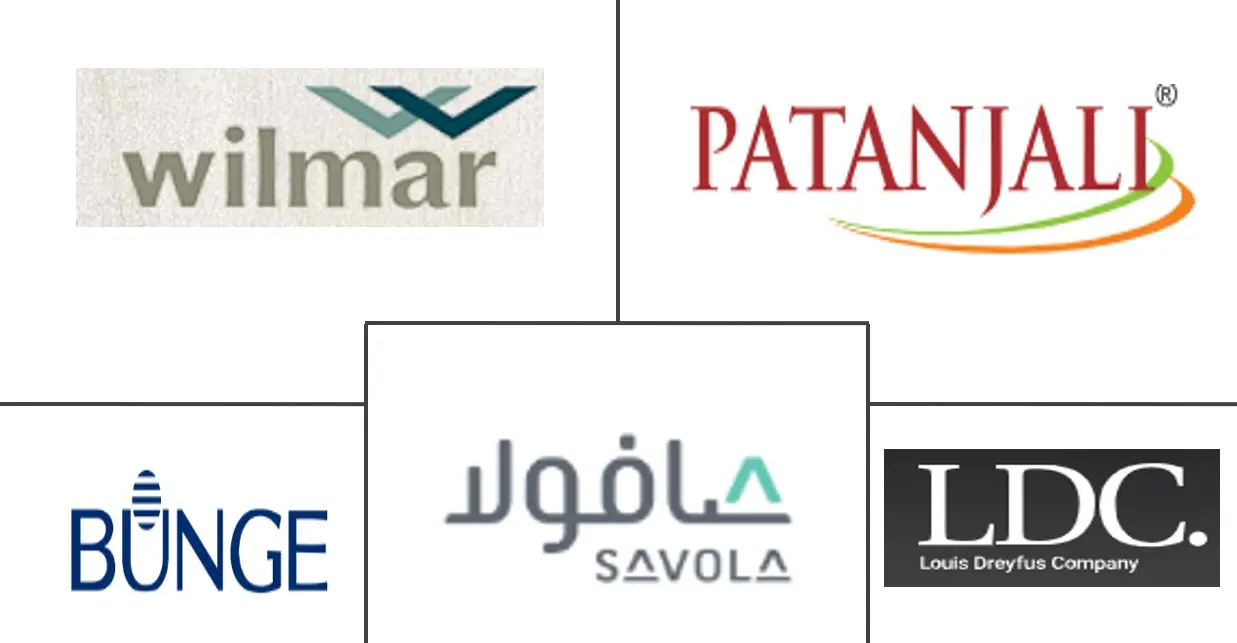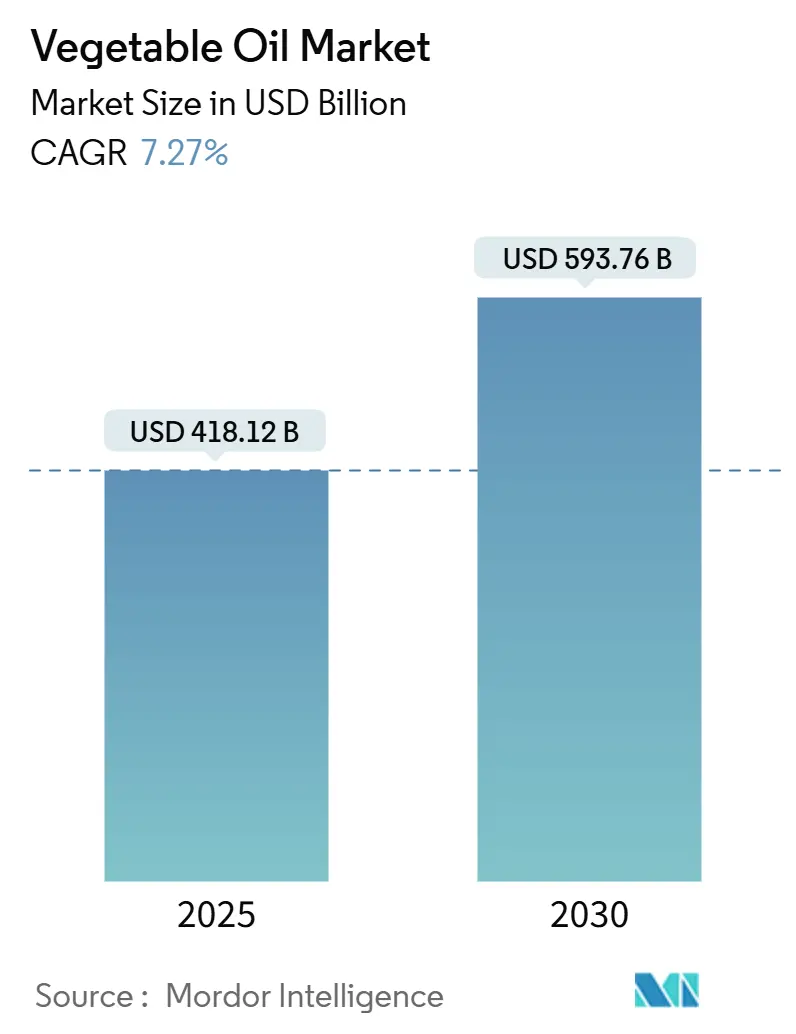
Vegetable Oil Market Analysis by Mordor Intelligence
The vegetable oil market is valued at USD 418.12 billion in 2025 and is forecast to advance at a 7.27% CAGR to reach USD 593.76 billion by 2030. Demand stays firm as population growth, expanding food processing and the rise of bio-based industrial uses support volume gains across key oil types. Sustainability targets are reshaping feedstock sourcing, prompting firms to adopt certified supply chains and invest in land-efficient crops. Consumer interest in heart-healthy and clean-label products is accelerating the switch toward sunflower, olive and other premium oils, while breakthroughs in waste-oil conversion create fresh end-market opportunities. Producers with integrated crushing, refining and packaging operations leverage scale to manage price volatility and protect margins, an advantage that encourages ongoing consolidation within the vegetable oil market.
Key Report Takeaways
- By product type, palm oil led with 28.56% of the vegetable oil market share in 2024; sunflower oil is projected to post the fastest 7.27% CAGR through 2030.
- By nature, the conventional segment commanded 93.52% share of the vegetable oil market size in 2024, while organic oils are forecast to expand at a 9.10% CAGR to 2030.
- By packaging, bottles accounted for 41.22% of the vegetable oil market size in 2024 and pouches are advancing at a 6.51% CAGR through 2030.
- By distribution channel, retail held 61.91% revenue share in 2024; HoReCa/Foodservice records the highest projected CAGR at 8.32% through 2030.
- By geography, Asia Pacific led with 48.73% share of the vegetable oil market in 2024; the region is also the fastest-growing at an 8.96% CAGR to 2030.
Global Vegetable Oil Market Trends and Insights
Drivers Impact Analysis
| Drivers | (~) % Impact on CAGR Forecast | Geographic Relevance | Impact Timeline |
|---|---|---|---|
| Rising health awareness shifts preference towards healthier oils like olive and sunflower | +1.8% | Global, with stronger impact in North America and Europe | Medium term (3-4 years) |
| Expanding food processing and fast-food industries boost oil consumption | +2.1% | Asia-Pacific core, spill-over to Middle East and Africa | Short term (≤2 years) |
| Increasing demand for organic and non-GMO oils fuels vegetable oil consumption | +1.5% | North America and Europe, emerging in Asia-Pacific | Medium term (3-4 years) |
| Growing urban population fuels higher demand for edible oils due to increased consumption needs | +1.2% | Asia-Pacific core, Middle East and Africa, South America | Long term (≥5 years) |
| Government policies supporting vegetable oil usage drive market growth | +0.6% | Global, with emphasis on developing economies | Medium term (3-4 years) |
| Expansion of the biofuel industry propelling market growth | +1.4% | Global, with stronger impact in Europe and North America | Medium term (3-4 years) |
| Source: Mordor Intelligence | |||
Rising health awareness shifts preference towards healthier oils like olive and sunflower
The rising health awareness among consumers is driving the demand for healthier oils, such as olive and sunflower, in the vegetable oils market. For instance, the United States Department of Agriculture (USDA) has highlighted the nutritional benefits of olive oil, including its high monounsaturated fat content, which supports heart health. Similarly, the European Food Safety Authority (EFSA) has endorsed sunflower oil for its rich vitamin E content, which acts as an antioxidant. According to the World Health Organization (WHO), replacing saturated fats with unsaturated fats, such as those found in olive and sunflower oils, can reduce the risk of cardiovascular diseases. Additionally, government initiatives promoting healthy eating habits, such as the "MyPlate" guidelines by the USDA, encourage the use of healthier cooking oils. These endorsements, coupled with increasing consumer awareness, are significantly influencing purchasing decisions and shifting preferences toward these healthier alternatives.
Expanding food processing and fast-food industries boost oil consumption
The growth of the food processing and fast-food industries is a significant driver of the vegetable oils market. For instance, according to the United States Department of Agriculture (USDA), the global consumption of vegetable oils reached approximately 218.41 million metric tons in 2023/24, driven by increased demand from food manufacturers and quick-service restaurants[1]U.S. Department of Agriculture, "USDA-oilseeds world trade markets and trade-2025", www.fas.usda.gov. The rising popularity of processed and convenience foods, particularly in emerging economies, has further fueled this demand. Additionally, government initiatives promoting food processing, such as India's Production-Linked Incentive (PLI) scheme for the food processing sector, are further boosting the demand for vegetable oils. For example, the PLI scheme aims to enhance the competitiveness of the food processing industry by providing financial incentives, which indirectly increase the consumption of vegetable oils used in manufacturing. Similarly, in the United States, the Food Safety Modernization Act (FSMA) has encouraged investments in food processing facilities, leading to higher utilization of vegetable oils. These developments underline the critical role of vegetable oils in meeting the rising consumption needs of these industries, as they are essential ingredients in frying, baking, and other food preparation processes.
Increasing demand for organic and non-GMO oils fuels vegetable oil consumption
Surging appetite for organic and non-GMO oils drives up vegetable oil consumption. For instance, the rising consumer preference for healthier alternatives has led to increased demand for organic sunflower oil and non-GMO soybean oil. Additionally, the food and beverage industry is incorporating these oils into their products to cater to health-conscious consumers, further boosting their consumption in the global vegetable oil market. Furthermore, regulatory support for organic farming and non-GMO labeling in regions like North America and Europe has encouraged manufacturers to expand their product portfolios, thereby driving the growth of this segment within the vegetable oil market. For example, companies such as Organic India have introduced organic oil variants to meet the growing demand. Similarly, the rise of e-commerce platforms has made these products more accessible to consumers, further accelerating their adoption. The increasing awareness of the environmental benefits of organic farming practices also plays a significant role in driving this demand, as consumers are becoming more conscious of sustainability and eco-friendly products.
Growing urban population fuels higher demand for edible oils due to increased consumption needs
In South and Southeast Asia, rapid urbanization is driving up per-capita oil consumption, bolstering the demand for frying, seasoning, and processed staples. A report from UN-Habitat highlights that Asia houses 54% of the global urban population, equating to over 2.2 billion people as of 2022. Projections suggest that by 2050[2]UN-Habitat, "Asia and the Pacific Region", www.unhabitat.org, Asia's urban population will expand by an additional 1.2 billion, marking a 50% surge. Furthermore, the Economic and Social Commission for Asia and the Pacific notes that Southeast Asian cities play a crucial role in the region's economy, accounting for 80% of its GDP. In India and China, national food-security initiatives emphasize self-sufficiency in oil seeds, leading to investments in crushing complexes linked to rail and river corridors. Looking ahead, demographic trends suggest a robust demand for vegetable oils, even as macroeconomic challenges temper discretionary spending in other areas.
Restraints Impact Analysis
| Restraint | (~) % Impact on CAGR Forecast | Geographic Relevance | Impact Timeline |
|---|---|---|---|
| Competition from synthetic and alternative fats affects demand | -0.9% | North America and Europe | Medium term (3-4 years) |
| Volatility in raw material prices affects market stability | -1.2% | Global | Short term (≤2 years) |
| Stringent government regulations on trans fats and labeling increase compliance costs | -0.7% | Global, with stronger impact in developed economies | Medium term (3-4 years) |
| Adulteration concerns hindering the market growth | -0.7% | Asia-Pacific core, Middle East and Africa, with regulatory spillover to developed markets | Short term (≤2 years) |
| Source: Mordor Intelligence | |||
Competition from synthetic and alternative fats affects demand
The market faces a significant restraint due to the rising competition from synthetic and alternative fats. These substitutes, often developed through advanced technologies, offer similar functionalities and benefits as vegetable oils, making them attractive to various industries, including food, cosmetics, and biofuels. Additionally, synthetic fats are often marketed as cost-effective and sustainable options, further intensifying the competition. The growing consumer preference for innovative and environmentally friendly products also contributes to the shift toward alternative fats. This trend challenges the growth potential of the vegetable oils market, as manufacturers must address these competitive pressures while maintaining their market share.
Volatility in raw material prices affects market stability
Volatility in raw material prices poses a significant restraint to the global vegetable oils market. The unpredictable nature of raw material costs, driven by factors such as fluctuating agricultural yields, geopolitical tensions, and changing trade policies, creates challenges for manufacturers. These price variations directly impact production costs, leading to instability in profit margins and pricing strategies. Additionally, the dependency on agricultural commodities, which are highly sensitive to climatic conditions, further exacerbates the issue. For instance, adverse weather conditions such as droughts or floods can significantly reduce crop yields, causing a surge in raw material prices. Furthermore, geopolitical events, including trade restrictions or tariffs, can disrupt the supply chain, adding to the unpredictability of costs. Such instability in raw material prices disrupts the supply chain, making it difficult for market players to maintain consistent product availability and affordability. This ongoing challenge underscores the need for strategic planning and risk management to mitigate the adverse effects on the global vegetable oils market.
Segment Analysis
By Product Type: Palm oil Retains Scale Advantage Amid Rising Scrutiny
Palm oil contributed 28.56% to the vegetable oil market in 2024, reflecting its high land-use efficiency and suitability for consumption across the retail and foodservice industry. Major producers in Indonesia and Malaysia deliver consistent output through estate management and mill modernization, though buyers increasingly request certified sustainable volumes. Ongoing debates around deforestation spur tighter traceability requirements, yet export flows remain robust due to cost-competitive yields. Sunflower oil, supported by crop recoveries in Eastern Europe, registers the swiftest 7.27% CAGR from 2025 to 2030 as processors target mid-premium snacks and ready meals that favor its clean flavor. Soybean oil retains a strong presence in the Americas, buoyed by the linkage between crush margins and high-protein meal demand for animal feed. Olive and coconut oils address premium and niche needs, respectively, adding diversity to the vegetable oil market.
The vegetable oil market size for palm derivatives is projected to grow steadily as biodiesel mandates expand in select Asian nations, offsetting slower adoption in markets wary of indirect land-use change. Sunflower oil’s share gains hinge on climatic stability and logistics resumption along Black Sea corridors. Soybean oil volumes tie closely to biofuel blending quotas in the United States, where renewable diesel capacity is scaling quickly. Specialty oils, including high-oleic rapeseed, command premium pricing in infant nutrition and bakery shortening, illustrating how functional traits can capture sub-segment share.
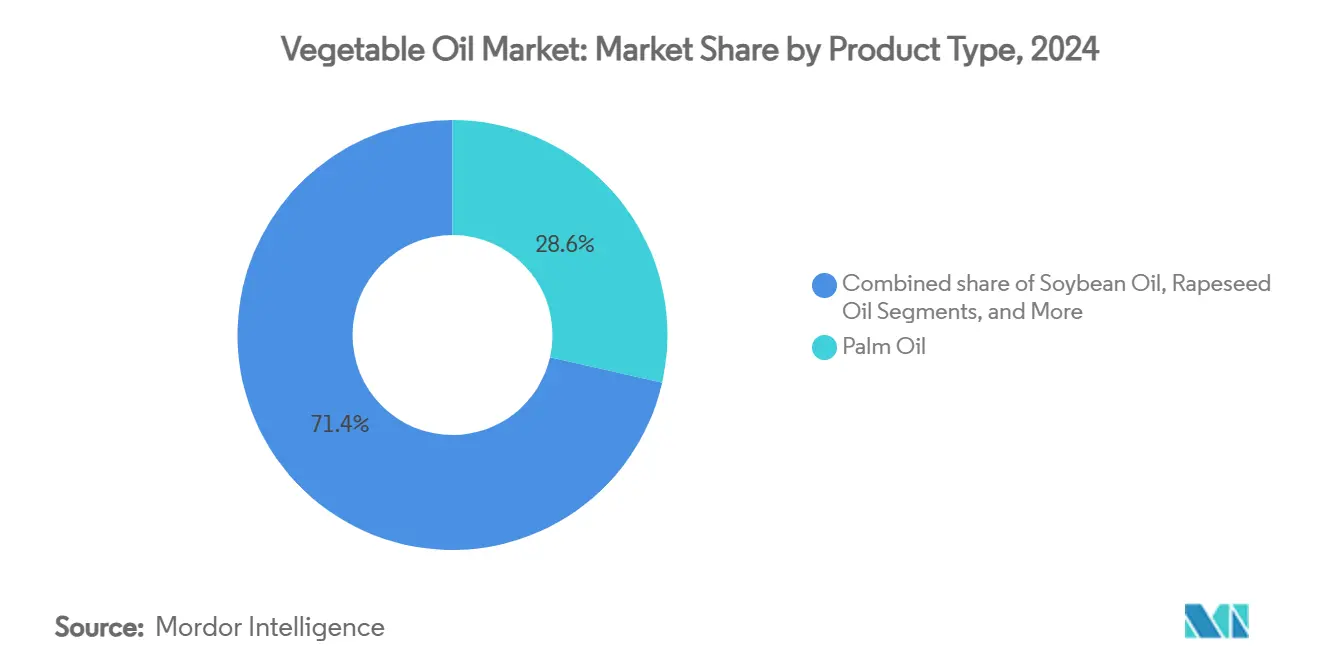
Note: Segment shares of all individual segments available upon report purchase
By Nature: Conventional Dominates While Organic Accelerates
Conventional oils accounted for 93.52% of the vegetable oil market in 2024, anchored by established supply networks, high output per hectare, and price sensitivities in mass-market food categories. Integrated agribusinesses run multi-seed complexes that streamline logistics, lowering unit costs. However, tightening deforestation rules and customer audits raise compliance spending, nudging refiners toward traceable feedstock programs. The organic segment, though only a fraction of the current volume, is projected to expand at a 9.10% CAGR through 2030, outpacing the broader vegetable oil market size. Conversion subsidies and premium retail margins foster grower interest, yet the three-year transition window constrains rapid acreage gains.
Sustained demand allows processors to capture higher per-ton margins on organic product lines, which include cold-pressed sunflower, extra-virgin coconut, and grass-fed ghee substitutes processed with organic soybean oil. Urban consumers equate organic labels with reduced pesticide exposure and soil health benefits, strengthening brand loyalty. Supply tightness occasionally leads to stock rationing, pushing premium differentials wider during peak holiday seasons. In parallel, conventional suppliers pilot regenerative agriculture programs to retain environmentally conscious buyers who may not require full certification.
By Packaging: Bottles Leads, Pouches Accelerates
Bottles remained the primary pack type in 2024 with a 41.22% share of the vegetable oil market, balancing product protection with consumer familiarity. Glass dominates in olive and specialty avocado oils, where clarity and perceived purity bolster premium positioning. Lightweight recyclable PET advances in high-turnover soybean and sunflower lines to cut freight costs. Innovation focuses on square or stack-friendly bottle designs that improve pallet density, helping retailers trim in-store logistics.
Pouches record the fastest 6.51% CAGR thanks to lower material use and easier disposal, aligning with corporate emissions targets. Advances in multilayer structures enhance barrier performance, ensuring shelf life comparable to rigid packs. Bag-in-box systems gain traction in foodservice channels for fry-stable blends, reducing workplace lifting injuries and waste. Refill initiatives emerge in select European markets where consumers decant vegetable oil into reusable glass at home. Paper-based composite cans retain relevance in infant formula oils, illustrating ongoing diversity in packaging within the vegetable oil market.
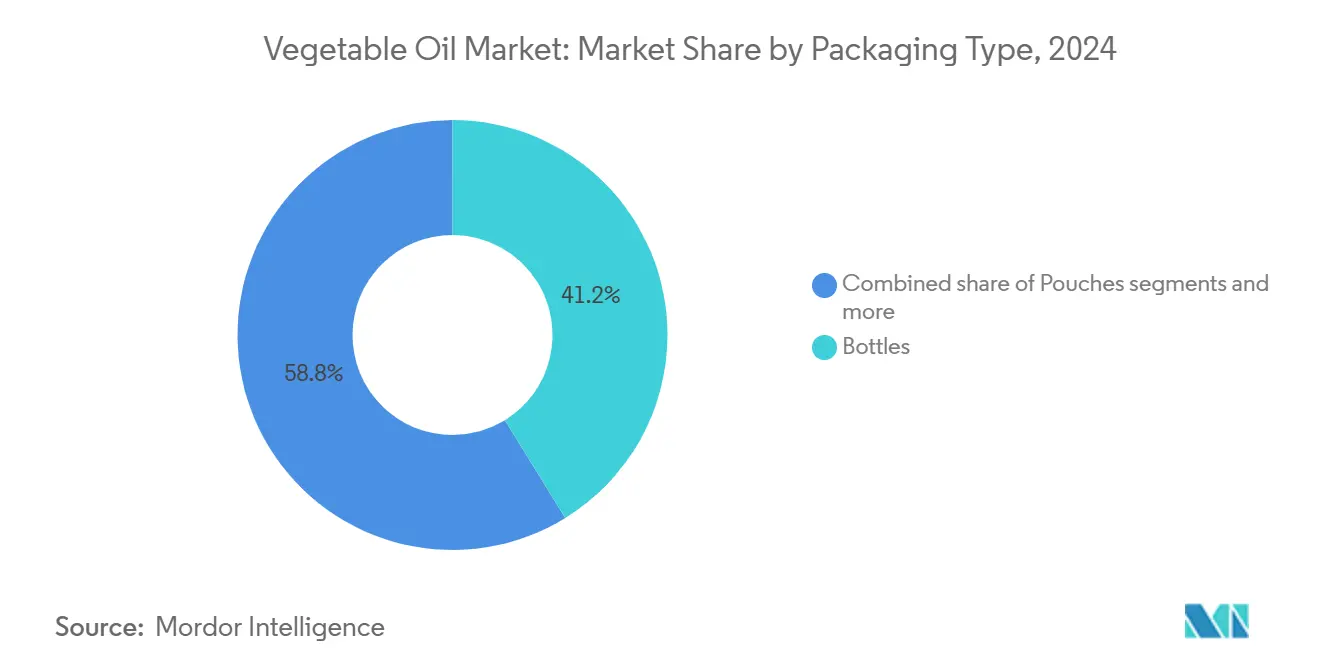
Note: Segment shares of all individual segments available upon report purchase
By Distribution Channel: HoReCa Rebounds Strongly
Retail outlets contributed 61.91% revenue share to the vegetable oil market in 2024, led by supermarkets that bundle private-label options with mid-tier branded lines. E-commerce doubles down on subscription models for cooking essentials, allowing brands to forecast demand and reduce out-of-stock events. Specialty grocers highlight provenance and cold-press processes, fostering the discovery of niche oils. Loyalty apps and recipe content encourage basket-building, lifting average order value.
The HoReCa/Foodservice channel is on track for an 8.32% CAGR through 2030 as dine-out habits normalise post-pandemic and quick-service brands accelerate outlet rollouts in secondary cities. Bulk packaging formats, such as 15-litre jerrycans and 20-litre bag-in-box, dominate procurement lists. Kitchen managers rank fry-life, smoke point, and filterability as top selection criteria, spurring suppliers to develop high-oleic palm-sunflower blends. Sustainability services, including spent-oil collection for renewable diesel, become part of vendor contracts, embedding circular practices in the vegetable oil market.
Geography Analysis
In 2024, Asia Pacific commands a dominant 48.7% share of the vegetable oil market and boasts the region's highest growth rate at an impressive 8.96% CAGR (2025-2030). This momentum fosters a self-reinforcing cycle of investment and expansion, as companies continue to capitalize on the region's growth potential. In 2023, Indonesia, the world's leading producer and exporter of palm oil, saw its oil palm production reach an estimated 47.08 million metric tons, as reported by the Ministry of Agriculture[3]Ministry of Agriculture Indonesia, "Central Bureau of Statistics", www.bps.go.id. India and China stand out as leading producers of soybean and peanut oils, respectively, catering to both domestic and international demand. The region's robust growth is fueled by a burgeoning population, increasing disposable incomes, and a surge in industrial applications extending beyond mere food processing, including biofuel production and cosmetics.
Europe's vegetable oil landscape is shaped by mature consumption habits and stringent regulations that steer both domestic production and imports. Notably, Europe tops the charts in margarine consumption, a trend largely propelled by the food processing sector, which relies heavily on vegetable oils as key ingredients. Efforts to phase out trans fats further bolster this market's growth, aligning with public health initiatives and consumer preferences for healthier alternatives. Sustainability issues hold significant sway in Europe, with regulations such as the European Deforestation Regulation prompting a reevaluation of supply chain practices for imported oils. These regulations aim to ensure traceability and compliance with environmental standards, reshaping the market dynamics.
South America, capitalizing on its agricultural prowess in soybean production, secures a prominent spot in the global vegetable oil arena, with Brazil and Argentina emerging as key exporters. Sustainability concerns increasingly shape the region's production landscape, as global buyers demand environmentally responsible sourcing. Major agribusiness firms are now prioritizing deforestation-free soy, especially from Brazil's Cerrado region, to meet these expectations.
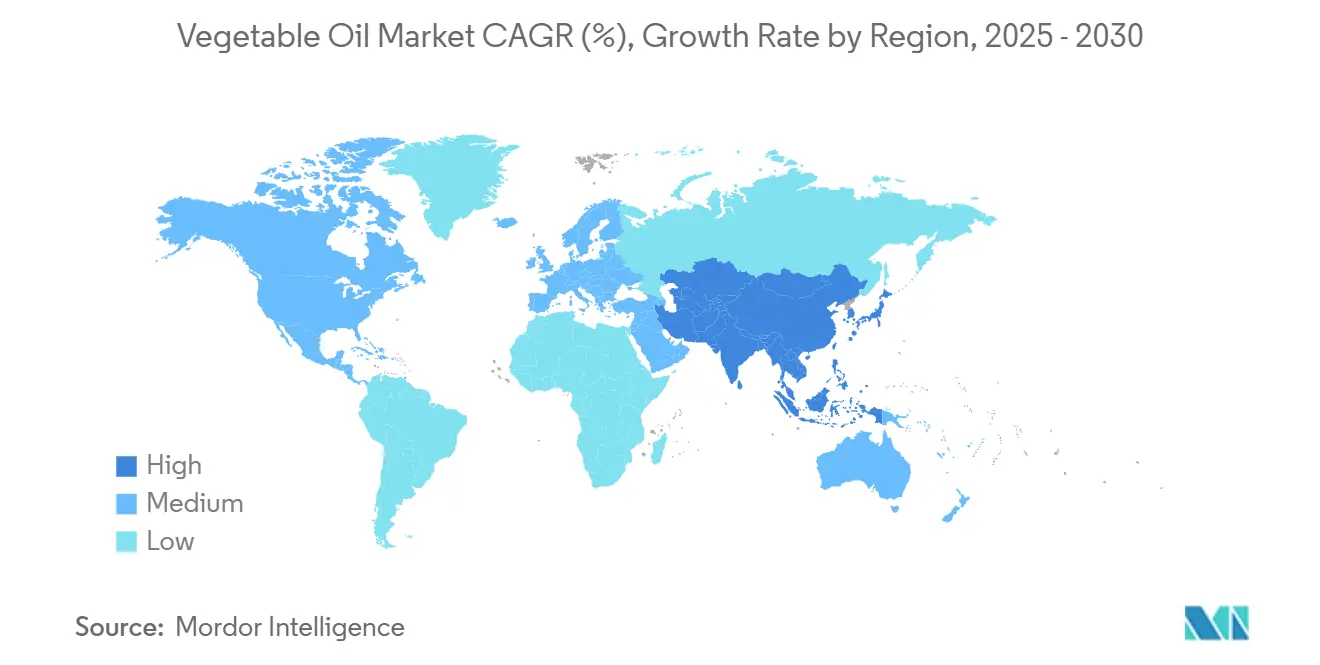
Competitive Landscape
The global vegetable oil market exhibits moderate fragmentation, which highlights the dominance of major integrated players, coexisting with a multitude of regional processors. Companies such as Wilmar International Limited, Bunge Limited, Louis Dreyfus Company B.V., The Savola Group, and Patanjali Ayurveda Limited leverage vertical integration, controlling the journey from agricultural production to consumer packaging. This approach enables these companies to maintain significant market shares while ensuring quality control and cost efficiency across the supply chain.
These key players actively focus on expanding their production capacities to meet the growing global demand for vegetable oil. They also prioritize enhancing supply chain efficiencies to reduce operational costs and improve delivery timelines. Furthermore, investments in research and development are pivotal for these companies as they aim to innovate and introduce new products that align with shifting consumer preferences, such as healthier oil options and sustainable production practices. Strategic partnerships, mergers, and acquisitions are frequently employed to strengthen their market positions and expand their presence in emerging markets.
The presence of numerous regional processors adds another layer of competition to the market. These processors primarily cater to localized demands, offering products at competitive prices to attract regional consumers. Their ability to adapt quickly to local market trends and preferences gives them an edge in specific regions. This dynamic competitive landscape emphasizes the critical need for operational efficiency, innovation, and adaptability for all market participants striving to sustain and grow their market share in an increasingly competitive environment.
Vegetable Oil Industry Leaders
-
Wilmar International Limited
-
Bunge Limited
-
Louis Dreyfus Company B.V.
-
The Savola Group
-
Patanjali Ayurveda Limited
- *Disclaimer: Major Players sorted in no particular order
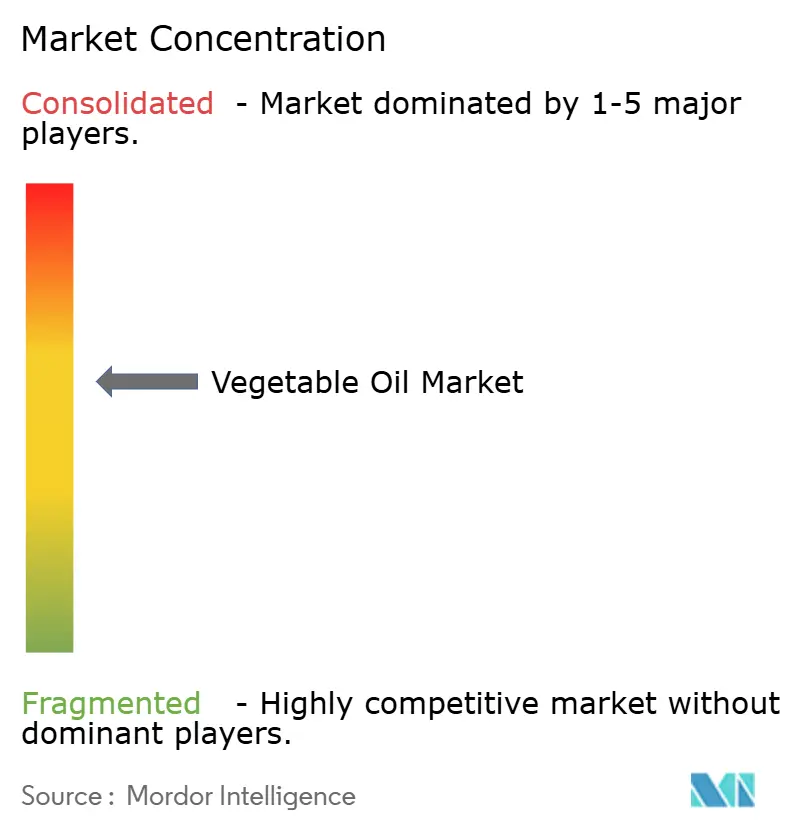
Recent Industry Developments
- April 2025: Tata Simply Better introduced two new flavors of its clean-label cold-pressed oils: extra-virgin olive oil and sesame oil. Packaged in 1 L PET bottles, these oils boast a commitment to purity, free from any hidden additives.
- January 2025: Borges India introduced its Single Variety Extra Virgin Olive Oils, crafted exclusively from 100% Arbequina and Picual olives, accessible through both online and offline platforms throughout India.
- September 2024: Kosterina launched two ultra-premium olive oils in over 600 Target stores nationwide, marking significant retail expansion for premium olive oil products and demonstrating growing mainstream consumer interest in specialty oils.
Research Methodology Framework and Report Scope
Market Definitions and Key Coverage
According to Mordor Intelligence, the global vegetable oil market includes every edible oil of plant origin that is mechanically or solvent-extracted, then refined, fractionated, or winterized for food, feed, and certified industrial uses, and finally traded in bulk or consumer packs at nominal USD value.
Scope Exclusion: specialty hydrogenated or recycled cooking oils marketed solely as bio-feedstocks lie outside the present study.
Segmentation Overview
- By Type
- Palm Oil
- Soybean Oil
- Rapeseed Oil
- Sunflower Oil
- Peanut Oil
- Coconut Oil
- Olive Oil
- Other Types
- By Nature
- Conventional
- Organic
- By Packaging
- Bottle
- Pouches
- Jar
- Can
- Others
- By Distribution Channel
- HoReCa/Foodservice
- Retail
- Supermarkets/Hypermarkets
- Convenience Stores/Grocery Stores
- Online Retail Stores
- Other Distribution Channels
- By Geography
- North America
- United States
- Canada
- Mexico
- Rest of North America
- Europe
- Germany
- France
- United Kingdom
- Spain
- Netherlands
- Italy
- Sweden
- Poland
- Belgium
- Rest of Europe
- Asia-Pacific
- China
- India
- Japan
- Australia
- South Korea
- Vietnam
- Indonesia
- Rest of Asia-Pacific
- South America
- Brazil
- Argentina
- Colombia
- Chile
- Peru
- Rest of South America
- Middle East and Africa
- Saudi Arabia
- United Arab Emirates
- South Africa
- Nigeria
- Egypt
- Morocco
- Turkey
- Rest of Middle East and Africa
- North America
Detailed Research Methodology and Data Validation
Primary Research
Mordor analysts conducted structured interviews and surveys with growers, refiners, importers, HoReCa buyers, and nutritionists across Asia, Europe, the Americas, and Africa, which validate yield assumptions, landed-cost spreads, and switching triggers between oil types, closing gaps left by desk work.
Desk Research
Our team begins with public datasets such as FAOSTAT balances, USDA Oilseeds Outlooks, UN Comtrade trade flows, WTO tariff filings, and WHO nutrition guidance, which anchor production, trade, and intake baselines. We then interpret regional policy papers (for example, RSPO updates, EU RED III mandates, India's National Mission on Edible Oils) alongside customs notices to capture regulatory shocks, while annual reports and 10-Ks from leading crushers illuminate price and margin trends. Subscription assets, notably D&B Hoovers for company splits and Dow Jones Factiva for news and deal tracking, enrich the picture. The sources named are illustrative only; many additional references support our evidence pool.
Market-Sizing & Forecasting
We launch a top-down reconstruction that layers crop output, crush rates, and net trade to size apparent consumption, which is then benchmarked against retail scanner panels and sampled ASP × volume checks from distributor discussions to fine-tune totals. Key variables modeled include planted acreage shifts, biodiesel blending mandates, disposable income per capita, new food-processing capacity, relative price spreads among major oils, and tariff revisions. A multivariate regression wrapped in scenario analysis delivers forecasts, while selective bottom-up supplier roll-ups provide cross-checks. Missing datapoints are bridged through three-year moving averages before final validation.
Data Validation & Update Cycle
Every model run passes variance filters, peer review, and a senior sign-off. The dataset refreshes yearly, with interim updates triggered by droughts, policy shocks, or major M&A, so clients always receive the latest view.
Why Mordor's Vegetable Oil Baseline Commands Reliability
Published estimates vary because firms pick dissimilar product baskets, price bases, exchange rates, and refresh cadences. Our clearly bounded edible-oil scope, current currency conversions, and annual recalibration give buyers a figure they can trace and trust.
Key gap drivers include some providers folding animal fats into totals, others freezing price assumptions at survey launch, and a few projecting forward from simple historical CAGR without yield or trade reconciliation. These external snapshots show 2024 values such as USD 250.78 B, 332.74 B, and 218.36 B.
Benchmark comparison
| Market Size | Anonymized source | Primary gap driver |
|---|---|---|
| USD 418.12 B (2025) | Mordor Intelligence | |
| USD 250.78 B (2024) | Global Consultancy A | Excludes coconut and olive oils, price base fixed at 2023 average |
| USD 332.74 B (2024) | Trade Journal B | Focuses on retail only, omits industrial demand and biodiesel pull |
| USD 218.36 B (2024) | Regional Consultancy C | Food-service scope only, forecast derived from historical CAGR |
The comparison shows that Mordor's disciplined scoping, variable-level modeling, and frequent reviews deliver a balanced, transparent baseline that decision-makers can rely on.
Key Questions Answered in the Report
What is the current size of the vegetable oil market?
The vegetable oil market stands at USD 418.12 billion in 2025.
How fast will the vegetable oil market grow over the next five years?
It is set to expand at a 7.27% CAGR, reaching USD 593.76 billion by 2030.
Which region contributes the largest share to the vegetable oil market?
Asia Pacific holds 48.73% of global revenue and is also the fastest-growing region.
Which oil type is growing the quickest?
Sunflower oil is projected to grow at a 7.27% CAGR between 2025 and 2030.
Why are pouches gaining ground in vegetable-oil packaging?
Pouches use less material, cut transport weight and now offer barrier properties that match bottles, supporting a 6.51% CAGR through 2030.
Page last updated on:
